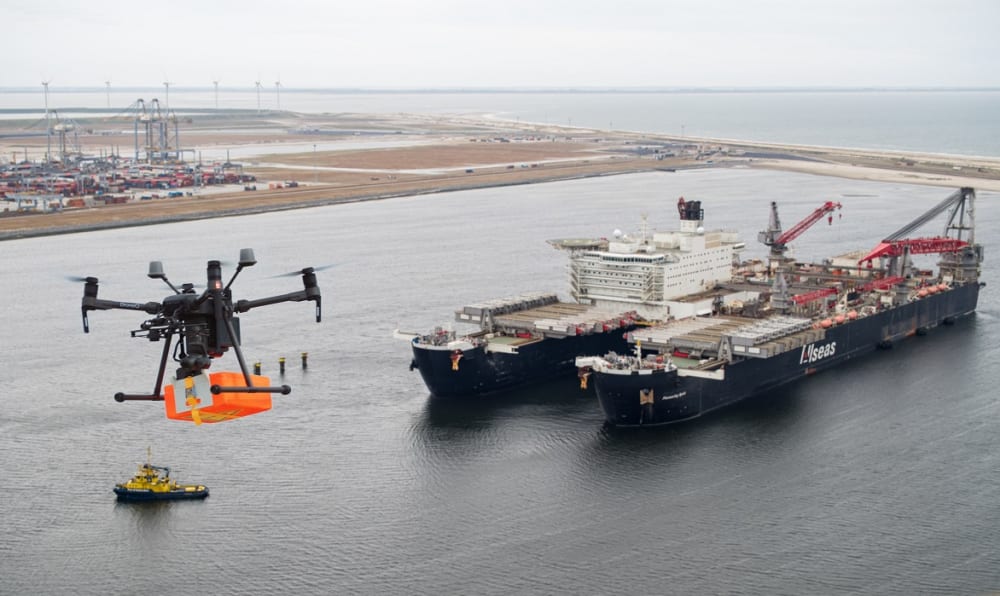
5G is to be an important part of urban air mobility, including drone delivery, according to Wind River. Pictured is the first Dutch drone delivery to a ship, the Pioneering Spirit crane ship, on May 22 off the Port of Rotterdam. The Dutch Delta Drone carried a small part – a network switch – to the ship. Photo: Port of Rotterdam Authority.
The deployment of 5G networks to enable rapid, high-bandwidth communications will be important for urban air mobility and defense, according to a new Wind River report, Solving 5G’s Biggest Challenges for Communications Service Providers.
The aerospace and defense (A&D) sector “is largely interested in 5G for its relevance to Urban Air Mobility as well as the potential to maintain global technology leadership and ensure defense communications are optimized and secure,” according to the report. The new Wind River report finds that 5G offers significant promise and challenges for communication services providers.
“The networks must be dense and complex and can potentially impose high operating and maintenance costs on carriers,” the report said. “Many, if not most, applications on 5G will require extremely low or deterministic latency. And of course, security is a factor to contend with as well.”
Capabilities that can overcome the security risks, “given the distributed and sometimes remote nature of 5G far edge nodes,” include Trusted Platform Module (TPM) to secure edge site hardware via cryptographic keys; Quick Assist Technology (QAT) with key protection; secure, Unified Extensible Firmware Interface (UEFI) boot; and zero touch updates, according to Wind River.
The deployment of 5G will be challenging, as the networks are dense and complex and come with potentially high operations and maintenance costs.
Wind River said that 5G will likely affect the design and architecture of the Radio Access Network (RAN), a collection of edge-located functions that connect a mobile device to the communication service provider’s core network.
To enable the low latency and high network loads of 5G, Wind River is offering a a new, cloud-based Virtual RAN (vRAN) approach under the the Wind River Cloud Platform. For the high density network requirements, Wind River is pursuing a Massive Multiple In Multiple Out (Massive MIMO) approach to wireless networking that maximizes data transfer through simultaneous sending and receiving and allows for the use of multiple antennas in data transmission and greater speed per antenna.
A Wind River survey published in April of 400 top executives in the United States and China found that a significant percentage are ramping up their 5G investments due to the effects of COVID-19. In the United States, 37 percent of industry 5G projects, including those in aerospace, have accelerated because of COVID-19, while, in China, 63 percent of such projects have moved up, the survey said.
5G is likely to be an important future technology for the military, as 5G is to enable high-bandwidth, real-time, densely-connected networks that will be central to leap-ahead defense command, control, and communications.
To that end, the Pentagon’s technology office has partnered with the Air Force Warfare Center to build a mobile 5G cellular network at Nellis Air Force Base in Nevada that will host software prototype tests starting next January, according to Avionics’ sister publication, Defense Daily.
The network is to feature relocatable cell towers that can be set up and taken down in less than an hour, as officials look to test possibilities for mobile operations centers and using 5G on the move.
The Pentagon fiscal year 2021 budget requested $449 million in research and development for 5G, $249 million more than provided by Congress last year.
On the commercial side, Gogo is developing new antennas and modems designed to enable the world’s first in-flight connectivity 5G air-to-ground (ATG) network by next year. Gogo has said that it is teaming with Cisco, Airspace, and First RF in Gogo’s development of its 5G system and network.
While Gogo furloughed 600 employees this month because of COVID-19’s impact on aviation, the company also said that the lay-offs would not affect the timeline of 5G. In a May 11 earnings call with investors, Barry Rowan, the chief financial officer for Gogo, said that the company is spending about $100 million for 5G development.
“Our spending for this [5G] program peaks at just under $50 million during 2021,” he said. “We could delay our Gogo 5G spending if required to meet our financial objectives. So what is the outcome of these detailed planning exercises? Even under the worst-case scenario, we meet our key financial objectives of maintaining the minimum liquidity we need to run the company and making our interest payments.”